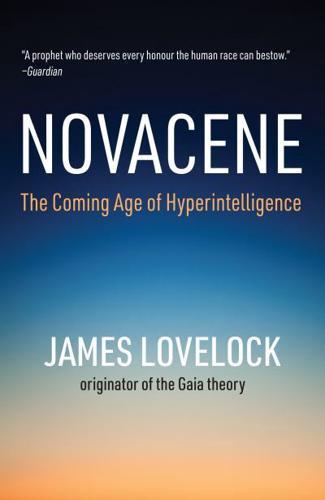Table of Contents
- Exploring the Novacene Concept and Its Implications for Humanity
- Understanding James Lovelocks Vision for a New Era
- The Science Behind Climate Change and the Novacene
- Practical Steps for Embracing the Novacene in Daily Life
- Reflecting on Lovelocks Legacy and Future Predictions
- Q&A
- In Retrospect

Exploring the Novacene Concept and Its Implications for Humanity
The Novacene concept, introduced by James Lovelock, presents a fascinating new epoch defined by the intersection of humanity and technology. This idea challenges the conventional boundaries we perceive between the natural world and artificial intelligence. As we navigate this emerging era, the implications for humanity become increasingly significant. Some of the core components of the Novacene narrative include:
- Environmental Synergy: The potential for advanced technologies to not only coexist with nature but actively enhance ecological systems.
- Intelligent Systems: The emergence of AI-driven frameworks that could help monitor and maintain the planet’s health.
- Ethical Considerations: Addressing moral dilemmas surrounding the rights of artificial entities and their role in our future.
Diving deeper, one can appreciate the transformative power that the Novacene presents. It compels us to reconsider our relationship with the biosphere, emphasizing a symbiotic partnership rather than one of dominance. This symbiosis offers a dual perspective on our technological advancements, suggesting that they could lead to greater sustainability efforts when designed with ecological considerations from the start. The potential outcomes include:
- Reduced Carbon Footprint: Leveraging AI for efficient energy management and resource allocation.
- Biodiversity Conservation: Utilizing technology to protect endangered species and restore ecosystems.
- Informed Decision-Making: Engaging data analytics for better global responses to climate crises.
Moreover, the societal ramifications of the Novacene cannot be overlooked. As we embrace this new age, the question of identity and belonging within an AI-enhanced environment emerges. Citizens will need to reevaluate their roles—not just as stewards of the Earth, but as active participants in a biotechnological revolution. Key areas of focus will include:
| Focus Area | Potential Impact |
|---|---|
| Education | Shifting curricula to incorporate ethics in technology use. |
| Employment | Developing new job sectors around AI sustainability practices. |
| Healthcare | Innovations for better health monitoring through AI. |

Understanding James Lovelocks Vision for a New Era
James Lovelock’s profound vision for a new era invites us to rethink our relationship with the Earth and its ecosystems. His concept urges a shift from the traditional anthropocentric view to a perspective that sees humanity as an integral part of a complex interconnected web of life. This shift in mindset is crucial as we face unprecedented environmental challenges, including climate change, biodiversity loss, and resource depletion. By embracing the idea that the Earth operates as a single, self-regulating organism, Lovelock emphasizes the need for sustainable practices to ensure a harmonious existence between humans and nature.
Central to Lovelock’s philosophy is the recognition that humans possess the technological means to either heal or harm the planet. He advocates for innovative solutions that leverage advanced technologies while remaining deeply attuned to natural processes. This holistic approach involves:
- Promoting renewable energy sources to reduce dependency on fossil fuels.
- Enhancing biodiversity through conservation and restoration initiatives.
- Encouraging local food systems that prioritize sustainability and resilience.
Moreover, Lovelock argues for a re-evaluated role of science and technology in fostering environmental stewardship. He suggests that the integration of scientific strategies with traditional ecological knowledge can yield comprehensive solutions to the crises we face. This integration paves the way for collaborative efforts that not only aim to mitigate harm but also actively promote regeneration. Through education and policy reform, Lovelock’s vision seeks to inspire a collective awakening to the responsibility we share in preserving the planet for future generations.

The Science Behind Climate Change and the Novacene
The phenomenon of climate change is rooted in a complex interplay of natural processes and human actions. The primary driver of recent climate changes is the rapid increase in greenhouse gas emissions, primarily from the burning of fossil fuels, deforestation, and industrial activities. When these gases accumulate in the atmosphere, they create an insulating layer that traps heat, leading to a gradual increase in global temperatures. This warming triggers a cascade of environmental changes, such as melting polar ice caps, rising sea levels, and shifting weather patterns.
James Lovelock, a notable scientist behind the Gaia theory, proposed that our planet operates as a self-regulating system. In the context of climate change, he introduces concepts associated with the Novacene, a term he coined to characterize a new epoch emerging from humanity’s interaction with technology. Lovelock argues that the integration of artificial intelligence and advanced technologies can potentially offer solutions to mitigate climate impacts. He emphasizes the need for a paradigm shift in how we perceive our relationship with nature—advocating for a partnership that leverages technological advancements to achieve ecological balance.
| Key Factors Contributing to Climate Change | Impacts of Climate Change |
|---|---|
| Fossil Fuel Emissions | Increased temperatures |
| D deforestation | Extreme weather events |
| Industrial Pollution | Loss of biodiversity |
| Agricultural Practices | Ocean acidification |
Understanding the science of climate change is vital for both current and future generations. The Novacene conceptualizes a future where technology aids in climate recovery rather than exacerbating the problem. Strategies such as carbon capture, renewable energy innovations, and sustainable agricultural practices are essential components in this technological toolkit. As we navigate this crossroads, continuous research and commitment to ecological stewardship will determine our collective path toward sustainability.

Practical Steps for Embracing the Novacene in Daily Life
Adapting to the Novacene allows individuals to integrate a more harmonious relationship with technology while being conscious of its impact on the environment. One practical step is to incorporate sustainable practices into daily routines. This can include:
- Reducing waste: Opt for reusable bags, water bottles, and containers.
- Choosing local produce: Support local farmers to minimize transportation emissions.
- Utilizing public transport: Encourage the use of bikes, buses, or trains to decrease carbon footprints.
Another pivotal aspect is fostering a mindset that appreciates and adapts to technological advances. Embracing digital tools for personal development can enhance both productivity and environmental awareness. Consider
- Learning through eco-focused apps: Utilize apps that promote sustainable living by providing tips or resources.
- Participating in online forums: Join communities that discuss innovations in environmental technology.
- Engaging with science communication: Follow blogs, podcasts, or video channels that explore Novacene concepts and practices.
Creating a collaborative ecosystem where technology serves nature involves connecting with like-minded individuals and organizations. By fostering these connections, you can:
- Volunteer for environmental initiatives: Get involved in local cleanup days or conservation projects.
- Attend workshops: Join educational sessions focused on sustainable technology and its implications.
- Share knowledge: Discuss your experiences and insights on social media platforms to raise awareness.

Reflecting on Lovelocks Legacy and Future Predictions
James Lovelock’s profound contributions to environmental science and climate awareness have fostered a legacy that continues to resonate today. His Gaia theory, which posits that Earth operates as a self-regulating system, revolutionized how we perceive ecological interactions and reinforced the interconnectedness of life. Through his unique perspective, Lovelock not only challenged established scientific paradigms but also advocated for a more holistic approach to understanding environmental issues. His work has laid the groundwork for an interdisciplinary dialogue, encouraging collaboration among scientists, policymakers, and the public.
As we look forward, the implications of Lovelock’s ideas become increasingly relevant. The paradigm shifts he championed have sparked discussions around sustainable practices and environmental stewardship. Key areas for future exploration based on his insights include:
- Advancements in climate technologies
- The importance of biodiversity preservation
- Interdisciplinary collaboration among scientists and environmentalists
In envisioning the future, it’s crucial to consider the balance Lovelock stressed between human activity and nature’s capacity to adapt. Predictions for the coming decades may include:
| Trend | Potential Impact |
|---|---|
| Increased reliance on renewable energy | Reduction in carbon footprint |
| Enhanced conservation efforts | Stabilization of ecosystems |
| Global awareness campaigns | Shift in public attitudes towards sustainability |
These future predictions highlight the urgency of integrating Lovelock’s philosophy into current initiatives. Only through understanding the intricate balance between technological development and ecological preservation can we hope to create a sustainable world for future generations.



0 Comments